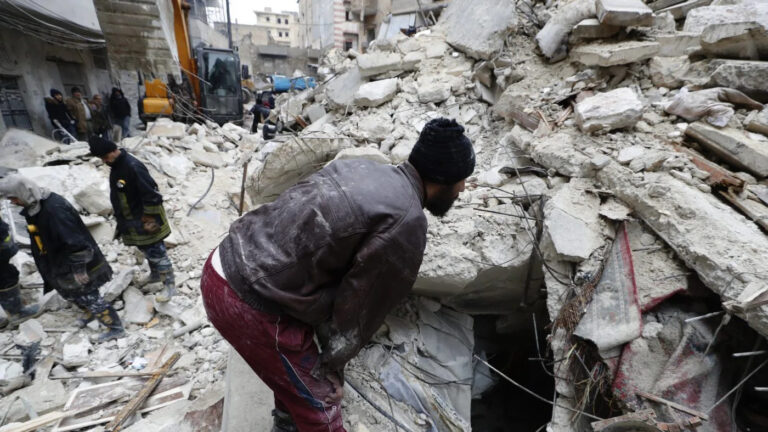Two months have passed since two big earthquakes hit Turkey and Syria, but the traumatic experience still lives with Melisa Gökmen.
“The moment I enter the house, I’m afraid that everything will happen again,” she told The Current.
Gökmen, 23, hasn’t stepped foot inside her apartment in Malatya, Turkey, since Feb. 6 — the day the 7.8 and 7.6 magnitude earthquakes hit. She’s spent the last several weeks in the Turkish city of Tekirdağ, where she’s receiving psychological help from a psychiatrist.
She said it’s been difficult to sleep at night knowing that her home survived the disaster while others around her fell.
“It’s going to be a long process for me to recover and get back to my old self,” she said. “It’s like seeing people suffer like this in the city I’ve lived in for 23 years, it burdens me. I was one of the lucky ones.”
“The area around our house has become a place full of debris. Surrounding schools, market buildings. None of them exist anymore. It looks like a place in horror movies.”
More than 236,000 buildings either collapsed or suffered significant damage in both Turkey and Syria, and over 50,000 people died.
Gökmen isn’t the only survivor who’s struggling to adapt to life after the disaster. Aid groups on the ground are warning of a looming mental health crisis.
The United Nations says more than 5.4 million children across the earthquake zone are at risk of developing anxiety, depression and post-traumatic stress disorder.
“I met a group of children and they mentioned that they are afraid of the darkness,” said Mehmet Ali Akil, Save the Children’s child protection co-ordinator in Antakya, Turkey.
“They cannot sleep. What they see — like bodies, their friends, their parents — they always think about that,” he told The Current‘s Matt Galloway.
The earthquakes have also affected how children interact with each other.
“Some kids became more aggressive with their siblings, with their friends, with their peers,” he said. “Some kids became more quiet and afraid of everything and they develop some attachment. They always want to be with parents or older siblings.”
Akil and other aid workers are trying to give children a bit of normalization and structure by creating safe spaces for them. In these spaces, “we dance, we are listening to music, play football. We try to give educational activities,” he said.
Support is not only limited to children. Akil said a chorus of parents and young adults have also been voicing concerns about their mental health and need for psychological assistance.
However, finding safe spaces has been a challenge on its own. Antakya was one of the cities badly impacted by the earthquakes, and according to its mayor, more than 50 per cent of the city is either under rubble or badly damaged — including Akil’s home.
“If you have emergency, if you want to go to hospital, the hospital is like tents. Also like some people living in the tents on the road,” Akil said.
Aid groups have been working hand-in-hand with local authorities to address the vast psychosocial needs. Turkey’s Ministry of Family and Social Services deployed more than 3,700 social workers across the quake zone.
But despite the co-ordinated response between government authorities and aid groups, Akil says needs on the ground far exceed available resources.
“We need the international community to step up again, so we can increase the number of our safe spaces and our programming to ensure children of all backgrounds have a safe space and start recovering,” he said.
Official numbers provided by Save The Children suggest that $40 million US is needed to provide families with food, shelter, blankets, and other basic essentials.
Syria’s complex response
In Syria, mental health resources have been stretched thin due to 12 years of civil war.
Now, aid workers are concerned about what burden the earthquakes will put on a community already in the middle of multiple humanitarian crises.
“It is estimated that more than one million people in northwest Syria need mental and psychosocial support — and only 24 psychologists are currently available,” said Nebras Haj Hamdan, Syria area co-ordinator for the NGO GOAL Global.
Hamdan said people in northwest Syria are not accustomed to earthquakes. So in the first few minutes of the tremors, some Syrians reacted by heading underground to their basements “as they’re used to when bombed.”
“We have seen some bodies of the victims in the basement of the buildings.”
Like Gökmen, some of those who survived are afraid to return home.
“A female colleague says, ‘As I went up to my apartment, I feel that the ground is moving me,'” Hamdan said. “So they prefer to stay in the tents.”
“Another colleague says that his daughter still wakes up terrified in the middle of the night saying, ‘There is an earthquake, Dad. Let’s get out.'”
Hamdan said agencies in Syria are offering consulting services, both for their own staff and the general public. But targeted psychological first aid intervention is needed to address other mental health concerns people are experiencing, he said.
GOAL expects the coming weeks to be even more difficult for people impacted. Aid groups working in northwest Syria are is facing funding cuts from donors whose resources are also being stretched thin from dealing with other crises elsewhere, like the drought in East Africa, floods in Pakistan, and the war in Ukraine.
“We are going to withdraw from 73 villages and towns from the food security support,” he told Galloway. “That means stop supporting 19,000 beneficiaries who are among the most needy people.”
He said GOAL is calling for more funding for their Syria earthquake response effort, as well as international pressure to renew the UN cross-border resolution that earlier on opened up more border crossing points between Syria and Turkey to allow more humanitarian aid to enter the country.
Source: cbc


